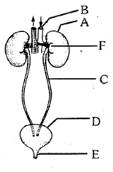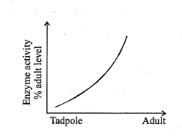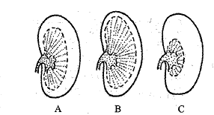In the diagram of excretory system of human beings given below, different parts have been indicated by alphabets, choose the answer in which these alphabets have been correctly matched with the parts which they represent -


| A | Kidney |
| B | Abdominal aorta |
| C | Ureters |
| D | Urinary bladder |
| E | Urethra |
| F | Renal pelvis |
| A | Kidney |
| B | Abdominal aorta |
| C | Urethra |
| D | Urinary bladder |
| E | Ureters |
| F | Renal pelvis |
| A | Kidney |
| B | Renal pelvis |
| C | Urethra |
| D | Urinary bladder |
| E | Ureters |
| F | Renal pelvis |
| A | Kidney |
| B | Abdominal aorta |
| C | Urethra |
| D | Urinary bladder |
| E | Renal pelvis |
| F | Ureters |

Important Questions on Excretory Products and Their Elimination
surface is ______ :-
Read statements and select the alphabet(s) for which the statement is correct.
| (A) | When some one drinks lot of water, ADH release is decreased. |
| (B) | Exposure to cold temperature suppress ADH release |
| (C) | Caffeine in Tea and coffee increase sodium absorption from DCT and collecting ducts |
| (D) | ADH also cause vasodilation |
Graph depicts the concentration of enzymes involved in urea synthesis in a developing tadpole. It indicates a transition from

The diagrams show vertical sections of kidneys of coypu, brown rate and kangaroo rat, showing the relative size of cortex and medulla. Coypu are found in freshwater and never short of water to drink. Brown rats are able to go some days without drinking at all. Which kidney belongs to which animal?

Identify the correct match from the column I, II and III:
| Column I | Column II | Column III |
| (1) PCT | (a) Podocytes | (i) Small amount of urea enter into it |
| (2) The inner wall of bowman's capsule | (b) Simple squamous epithelium | (ii) Conditional reabsorption |
| (3) Thin ascending segment of loop of Henle | (c) Cuboidal epithelium with less brush border | (iii) Part of filtration membrane |
| (4) DCT | (d) Cuboidal epithelium with more brush border | (iv) Maximum reabsorption of salt and electrolytes |
